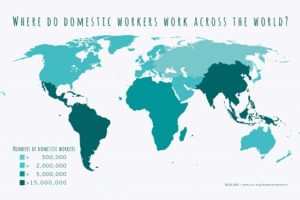Domestic workers comprise a significant part of the global workforce in informal employment and are among the  most vulnerable groups of workers. They work for private households, often without clear terms of employment, unregistered in any book, and excluded from the scope of labour legislation. Currently there are at least 53 million domestic workers worldwide, not including child domestic workers and this number is increasing steadily in developed and developing countries. Even though a substantial number of men work in the sector – often as gardeners, drivers or butlers – it remains a highly feminized sector: 83 per cent of all domestic workers are women.
most vulnerable groups of workers. They work for private households, often without clear terms of employment, unregistered in any book, and excluded from the scope of labour legislation. Currently there are at least 53 million domestic workers worldwide, not including child domestic workers and this number is increasing steadily in developed and developing countries. Even though a substantial number of men work in the sector – often as gardeners, drivers or butlers – it remains a highly feminized sector: 83 per cent of all domestic workers are women.
Their work may include tasks such as cleaning the house, cooking, washing and ironing clothes, taking care of children, or elderly or sick members of a family, gardening, guarding the house, driving for the family, and even taking care of household pets.
A domestic worker may work on full-time or part-time basis; may be employed by a single household or by multiple employers; may be residing in the household of the employer (live-in worker) or may be living in his or her own residence (live-out). A domestic worker may be working in a country of which she/he is not a national, thus referred to as a migrant domestic worker.
At present, domestic workers often face very low wages, excessively long hours, have no guaranteed weekly day of rest and at times are vulnerable to physical, mental and sexual abuse or restrictions on freedom of movement. Exploitation of domestic workers can partly be attributed to gaps in national labour and employment legislation, and often reflects discrimination along the lines of sex, race and caste.
For More Details : http://www.ilo.org/global/docs/WCMS_209773/lang–en/index.htm
 مركز تفوق الإستشاري للتنمية نحو مجتمع واعٍ و مسؤول
مركز تفوق الإستشاري للتنمية نحو مجتمع واعٍ و مسؤول
